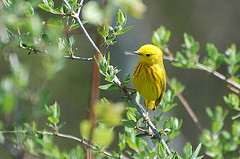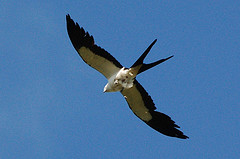
A Bird Trail is more than a trail in the literal sense. It is a “necklace” of sites, usually linked by a physiographic feature such as a river, that are united by the theme of “great for bird watching!” Birding Trails are essentially driving routes that help you get from one prime birding spot to the next.
The first Birding Trail was established in Texas in 1996. The
American Birding Association provides a partial list of birding trails located across the United States. To plan a trip or simply learn more about the trail in your region, click one of the ABA's listed links for trails around the country. Individual sites provide may sell bird trail maps, provide free general information, or even detailed maps showing routes to specific sites such as national, state, and municipal parks, boat launches, and private areas.
For example, the
Great River Birding Trail runs the entire length of both sides of America’s Greatest River, the Mississippi. According to the
National Audubon Society, “the river and its 30-million-acre floodplain form an internationally significant flyway for migratory birds and provide destinations for millions of Americans who enjoy birding and whose visits enrich local economies.”
Important Bird Areas
The Important Bird Areas, or IBA program, “is a global effort to identify and conserve areas that are vital to birds and other biodiversity,” begun by BirdLife International in the 1980s. National Audubon is BirdLife’s U.S. partner for IBAs and has worked with other nonprofits, agencies, landowners, and community groups to designate more than 380 million acres-worth of IBAs in 47 states as of 2010.
Identification and designation of IBAs is a strategic means of communicating the importance of these areas to decision makers. The program also seeks to assist landowners and local groups to minimize habitat loss and degradation.
Audubon states that “to qualify as an IBA, sites must satisfy at least one of the following criteria. The site must support:
- Species of conservation concern (e.g. threatened and endangered species)
- Restricted-ranges species (species vulnerable because they are not widely distributed)
- Species that are vulnerable because their populations are concentrated in one general habitat type or biome
- Species, or groups of similar species (such as waterfowl or shorebirds), that are vulnerable because they occur at high densities due to their congregatory behavior.”
A
map of all US IBAs is available, searchable by state.
If You are a Private Landowner
Even withou

t being a bird watcher, knowledge of
your proximity to Important Bird Areas or parts of a nearby Birding Trail will be important if you have an interest in
natural heritage tourism. If you have ever considered promoting some form of agritourism on your property, birding is a popular pastime that not only appeals to adults but increasingly serves as a hook for kids participating in environmental education programs. A first step to consider would be inviting a local bird group or university students to visit your property during different seasons and develop a bird list.